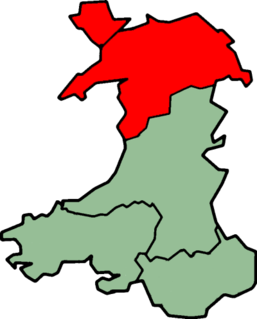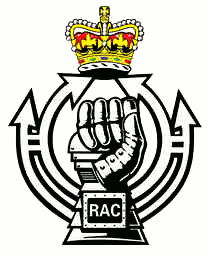A private is a soldier of the lowest military rank.
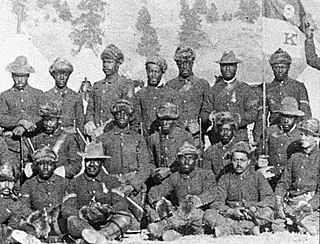
A troop is a military sub-subunit, originally a small formation of cavalry, subordinate to a squadron. In many armies a troop is the equivalent element to the infantry section or platoon. Exceptions are the Royal Horse Artillery and the US Cavalry, where a troop is a subunit comparable to an infantry company or artillery battery.

The structure of the British Army is broadly similar to that of the Royal Navy and Royal Air Force, in that the four-star (general-equivalent) field commands have been eliminated. Army Headquarters is located in Andover, Hampshire. As the top-level budget holder, this organisation is responsible for providing forces at operational readiness for employment by the Permanent Joint Headquarters. There is a Commander Field Army and a personnel and UK operations command, Home Command.
Corporal is a military rank in use in some form by many militaries and by some police forces or other uniformed organizations. Within NATO, each member nation's corresponding military rank of corporal is combined under the NATO-standard rank scale code OR-3 or OR-4. However, there are often differences in how each nation employs corporals. Some militaries don't have corporals, but may instead have a Junior Sergeant.

A sapper, also called pioneer or combat engineer, is a combatant or soldier who performs a variety of military engineering duties such as breaching fortifications, demolitions, bridge-building, laying or clearing minefields, preparing field defenses, as well as working on road and airfield construction and repair. They are also trained to serve as infantry personnel in defensive and offensive operations. A sapper's duties are devoted to tasks involving facilitating movement, defence and survival of allied forces and impeding those of enemies. The term "sapper" is used in the British Army and Commonwealth nations, Polish Army and the U.S. military. The phrase "sapper" comes from the French saper.

The Royal Logistic Corps (RLC) provides logistic support functions to the British Army. It is the largest Corps in the Army. The RLC flag is dark blue with the Corps Badge emblazoned on the centre. It has a Corps of Drums and a "Marching Band".
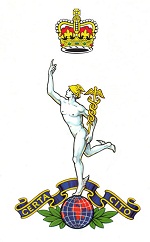
The Royal Corps of Signals is one of the combat support arms of the British Army. Signals units are among the first into action, providing the battlefield communications and information systems essential to all operations. Colloquially referred to by some as "Siggies", Royal Signals units provide the full telecommunications infrastructure for the Army wherever they operate in the world. The Corps has its own engineers, logistics experts and systems operators to run radio and area networks in the field. It is responsible for installing, maintaining and operating all types of telecommunications equipment and information systems, providing command support to commanders and their headquarters, and conducting electronic warfare against enemy communications.

Honi soit qui mal y pense is a French maxim used as the motto of the British chivalric Order of the Garter. It is translated as "May he be shamed who thinks badly of it" or "Shame be to him who thinks evil of it" or "Evil be to him that evil thinks." In contemporary French usage, it is usually used to insinuate the presence of hidden agendas or conflicts of interest.
Ensign is a junior rank of a commissioned officer in the armed forces of some countries, normally in the infantry or navy. As the junior officer in an infantry regiment was traditionally the carrier of the ensign flag, the rank acquired the name. This rank has generally been replaced in army ranks by second lieutenant. Ensigns were generally the lowest ranking commissioned officer, except where the rank of subaltern existed. In contrast, the Arab rank of ensign, لواء, liwa', derives from the command of units with an ensign, not the carrier of such a unit's ensign, and is today the equivalent of a major general.

The term used to refer to all ranks below officers is "other ranks". It includes warrant officers, non-commissioned officers ("NCOs") and ordinary soldiers with the rank of private or regimental equivalent. Officers may, in speaking, distinguish themselves from those "in the ranks".
Colonel-in-Chief is a ceremonial position in a military regiment. It is in common use in several Commonwealth armies, where it is held by the regiment's patron, usually a member of the royal family. The position was formerly used in the armies of several European monarchies. A Colonel-in-Chief has a purely ceremonial role in their regiment.
The regular army of the British Army is listed according to an order of precedence for the purposes of parading. This is the order in which the various corps of the army parade, from right to left, with the unit at the extreme right being highest. Under ordinary circumstances, the Household Cavalry parades at the extreme right of the line. Militia and Army Reserve units take precedence after Regular units with the exception of The Honourable Artillery Company and The Royal Monmouthshire Royal Engineers.

The uniforms of the British Army currently exist in twelve categories ranging from ceremonial uniforms to combat dress. Uniforms in the British Army are specific to the regiment to which a soldier belongs. Full dress presents the most differentiation between units, and there are fewer regimental distinctions between ceremonial dress, service dress, barrack dress and combat dress, though a level of regimental distinction runs throughout.
24 Commando Royal Engineers is a unit of the British Army's Royal Engineers which supports 3 Commando Brigade Royal Marines.
The Volunteer Force was a citizen army of part-time rifle, artillery and engineer corps, created as a popular movement throughout the British Empire in 1859. Originally highly autonomous, the units of volunteers became increasingly integrated with the British Army after the Childers Reforms in 1881, before forming part of the Territorial Force in 1908. Most of the regiments of the present Territorial Army Infantry, Artillery, Engineers and Signals units are directly descended from Volunteer Force units.
The Hong Kong Adventure Corps is a voluntary uniformed group subsidised by the Hong Kong government and the Hong Kong Jockey Club. It was created in 1995 with ties to the British Army's Army Cadet Force and Combined Cadet Force. Like the Hong Kong Sea Cadet Corps and Hong Kong Air Cadet Corps, the HKAC exists to serve the Hong Kong community. The HKAC's values are based in those of the British Army, providing a tough and challenging training with a distinctive military tone of discipline and esprit de corps.
Junior Leaders was the name given to some Boys' Service training Regiments of the British Army that took entrants from the age of 15 who would eventually move on to join adult units at the age of 17 and a half. Their aim was to produce and train the future Non-commissioned officers for their Regiment or Corps.
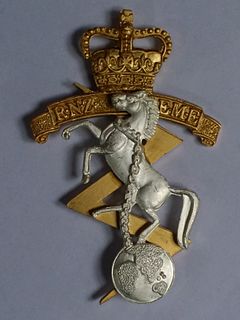
The Royal New Zealand Electrical and Mechanical Engineers (RNZEME) was a New Zealand Army Corps comprising Army trained tradesmen (craftsmen) who repaired Army equipment wherever New Zealand Forces served.
The 1946 King's Birthday Honours, celebrating the official birthday of King George VI, were announced on 13 June 1946 for the United Kingdom and British Empire.

